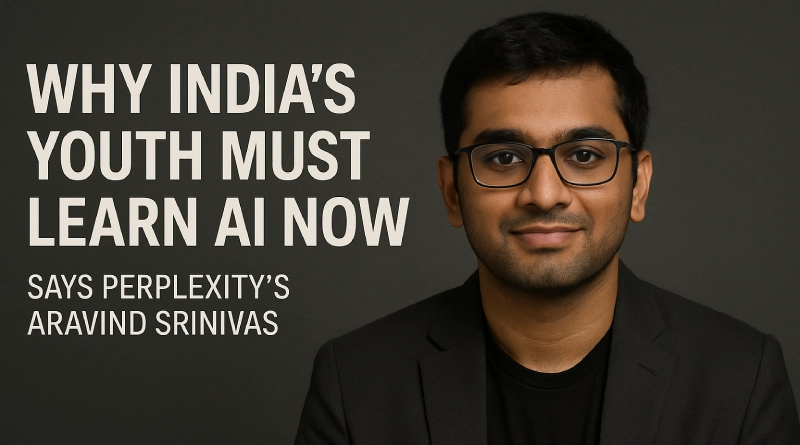Aravind Srinivas, the Indian-born CEO of Perplexity AI, has sent a clear message to India’s youth: stop browsing through social media all the time and start using artificial intelligence (AI) to get ahead in the job market. In a July 2025 interview with tech YouTuber Matthew Berman, Srinivas made it clear that being good at AI is no longer an option; it’s a must-have skill for getting a job. His message strikes a chord with young people in India, who will have both possibilities and challenges in a tech-driven future as the country tries to become a global AI hub. This article looks at Srinivas’s counsel, what it means for India, and how young Indians might use it in their own lives, all based on reliable sources and the local situation.
A Chennai-born graduate of IIT Madras with a doctorate degree in artificial intelligence from the University of California, Berkeley, Srinivas alerts that the workforce is being restructured faster than ever before by AI. Instead of doomscrolling through Instagram, he challenged, spend more time utilizing the AIs, because they were changing every three to six months, and they adapted faster than humans. People who learn to use such AI tools as the Perplexity Comet browser or sophisticated models such as GPT-5 will be “so much more employable” than others. And in India, the IT sector has more than 5 million workers with a national impact of 8 percent on the GDP, and it is also undergoing a challenge to disruptive automation via AI technology.
The Indian younger generation, in excess of 600 million aged under 25, is in an impasse. The India AI Mission, introduced in 2024, forecasts that by 2027, the AI market will triple to 17 billion dollars, leaving an opening in the need for talent among the organization to fill the gap. Nevertheless, according to a 2025 report by NASSCOM, only 10 percent of Indian people getting graduation degrees are AI-ready, and solving that skills problem was the goal of the advice that Srinivas gave. Learning AI will enable young Indians to be fitted into the new sectors, which include AI-enabled search, data analytics, and autonomous systems.
Srinivas estimates that AI will automate routine work such as recruiting and administration and will thus eliminate jobs such as recruiters and executive assistants. According to him, sourcing candidates or booking meetings can be simplified to a single reminder with the use of tools, such as Comet, that manage workflows in advance on the Decoder podcast of On The Verge. This automation in India can cause entrance-level employment to be disrupted since the call centers and the IT service industry have millions of employees. Nevertheless, Srinivas finds entrepreneurship as a solution; he urges younger generations to create their own companies or invest in new ones with the help of AI technologies.
To Indian students, it means a change of direction with regard to traditional careers. An increase in the AI-based startups in Bengaluru and Hyderabad presents chances to change up industries such as fintech, healthcare, and agriculture. To give an example, the partnership between Paytm and Perplexity that occurred in 2025 and saw the former incorporating AI-powered search into its application illustrates how local firms are currently harnessing the power of AI to improve user experiences and generate the demand for AI-knowledgeable personnel.
The youth of India can come to the rescue in this. Being the best at training AI models, they can join in the projects such as Krutrim, an Indian AI startup that builds vernacular AI models, and even help big players such as Perplexity to plan to provide free subscriptions of the Pro version to 360 million users in Airtel. These programs make AI more democratized so that students in Tier-2 and Tier-3 cities can train themselves and compete with the rest of the world.
Srinivas identifies an example of a psychological and systemic obstacle to the use of AI. He says humanity is not so good at quickly adapting to new things and highlights that inefficient educational tools and the blistering development of AI make the process of learning rather challenging. This is further worsened by a strict education system in India, with only 15 percent of the total colleges offering AI-specific curriculum, as a report conducted by AICTE indicates in the year 2025. When it comes to tools, such as Claude or GPT-4.1, it is difficult to keep up with the students, as reskilling is needed continuously.
In this regard, Srinivas proposes curiosity-driven learning. Reliving his own experience, he says Kaggle competitions awakened his passion in AI when he was in IIT. In India, the young generation can also do the same by turning to websites such as Kaggle, Coursera, or Labs of Perplexity, where people can gain experience in AI. There can also be AI hackathons in universities such as IIT Madras and startups in Bengaluru.
Srinivas has a relatable background to set his advice more firmly in reality since he grew up in Chennai and had to do an internship in Bengaluru. He remembers how he would choose to stay at work and not go out in Bengaluru because of its evil traffic, which is a universal feeling held by Indian students as well. India, the country with the highest number of AI startups, has its tech capital in Bengaluru: more than 30 percent of all AI startups are in this city, inhabited by a large population of young entrepreneurs. Other cities, such as Hyderabad and Pune, are also setting up as AI hubs, with Microsoft and Google putting out AI R&D branches on an expansion scale. Learning AI, the students of such cities could access local opportunities: trainee positions and startup projects.
The urgency of action, according to Srinivas, does not proceed without a caveat; namely, the adoption of AI should be ethical and inclusive. His opening note to entrepreneurs is that they should sleep with the fear that there are big companies that may steal what they have developed and not think about ideas but execution. This tip is essential in India, where data protection and AI ethics are becoming a perception issue. The Digital Personal Data Protection Act requires responsible use of AI in 2025, and young developers will be required to focus on ethical AI implementation in order to gain trust.
In practice, Srinivas recommends accessing easy-to-use tools. There is a free initiative called Perplexity, accessible through Airtel, that permits students to play with an AI-assisted search, whereas open-source sources, namely Hugging Face, contain model-training assets. They reduce the barriers to entry and can give students in smaller cities such as Coimbatore or Indore a chance to take part in the AI revolution.
Srinivas does not only see individual careers, but also he sees India as a world leader in AI. He envisions India following the same achievement in the IT service sector business to the AI industry, with 1.5 million STEM graduates annually. This is supported by the investment of the government in its AI infrastructure of 10,000 GPUs at a cost of 1.2 billion dollars. Nevertheless, a few obstacles still exist, such as poor AI curriculum and an insufficient number of high-performance computing tools in rural communities.
Srinivas promotes the use of public-private partnerships so as to reduce this rift. The cooperation of Perplexity with Airtel is an illustration of the ways in which international companies could contribute to the India AI ecosystem. Community programs such as these AI training programs by NVIDIA in India can also empower young people through education. The potential of AI in India by the year 2030 is to contribute 10 percent of the world’s AI talent, and the students today are determined to achieve this objective.
Aravind Srinivas’s message to India’s young people is a wake-up call: to do well in a world driven by technology, they need to learn how to use AI. India’s AI market is about to explode, and competition from around the world is getting tougher. To stay employable and creative, young Indians need to use AI tools like Perplexity’s Comet and open-source platforms. India’s youth can help the country become a leader in AI by breaking down systemic hurdles, encouraging curiosity, and putting ethical AI use first. Srinivas said it best: “Learn AI or get left behind.” Now is the time to act, and India’s future depends on its young people taking advantage of this chance.


